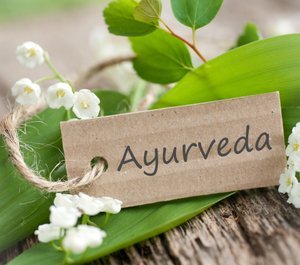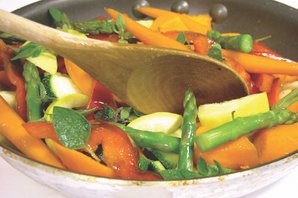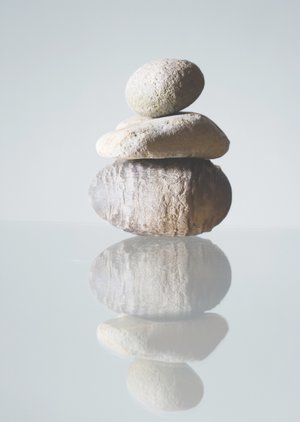Peace of mind creates flow in the body
Ayurveda
Ayurveda, which means science of life, provides a very profound knowledge on how the body and the mind are brought into balance and how diseases are avoided. By means of herbal medicine, detoxification, proper food etc, Ayurveda increases health, vitality and well-being and reduces discomfort, imbalances and disease.
You can learn everything about Ayurveda by listening carefully to yourself. The more intense you listen, the more you will spontaneously follow the many tips on food and health, as described in the ancient ayurvedic texts.
If you make it a practice to listen to your body every day, you will spontaneously experience the truths that were described thousands of years ago in the health care system.
A healthy digestion
The digestion is very important for the health, and the great majority of diseases can be avoided if the digestion functions optimally.
The digestion transforms and assimilates the food we eat, and determines how much life force we gain. A healthy digestion can transform almost anything, while a weak digestion has difficulty getting nourishment from even the most life-supporting food.
When the digestion is working optimally, the body radiates waves of joy and health, and life flows. A less efficient digestion produces waste products. These waste products stick all over the body and hinder the communication between the various body parts.
If you want to know how it feels to have waste products in the body, then try eating a plate of chocolate just before bedtime. The next morning you will probably wake up with stiffness in the body, feeling drowsy and lethargic, and have a bad taste in the mouth due to the coating on the tongue. It is because the chocolate is hard to digest, and because the digestion is not working particularly well during sleep.
Do not worry if you have waste products in the body. They can easily be cleansed, for example, by using boiled hot water (once the water has been boiled, it can be drunk as hot as you find comfortable). Try a couple of weeks where you drink small sips of boiled hot water every half an hour during the day, while continuing to eat regular meals. The boiled water will cleanse most of the waste products and you’ll feel clearer, more alert and energetic.
Once you have purified the body, it is important to strengthen the digestion in order to avoid the creation of new wasts. It can be done by eating life-supporting food, and by following the many pieces of ayurvedic advice like:
Eat the largest meal at midday
The digestion is strongest at midday. Therefore the largest meal should be eaten at lunch. Supper can be lighter and taken quite early, because it is important that the food is digested before bedtime. Sleep and digestion does not fit together, and the combination creates impurities in the body.
After lunch a rest a while, after dinner walk a mile
This old English proverb underlines that the digestion works best at midday. You don’t have to exercise after lunch to increase the digestive power, but it is recommended to eat lighter at dinner, when the digestion is less strong.
Eat when you’re hungry
Hunger is a sign that the body needs energy and nutrition. It is important to eat regularly for the body to function properly.
Digestion is like a bonfire - skipping meals is like not adding wood to it, so that it burns out; likewise, overeating is like adding too much wood and thereby suffocating the fire. Therefore it is best to eat regular meal of moderate sizes, in order to maintain a healthy digestion. Fasting can be done once in a while, if need be.
If you eat before the previous meal is digested, the body does not digest the food optimally, and waste products are created.
Eat at the same times every day
The body remembers what happened yesterday. If you one day eat at 8 am, noon and 6 pm, then the body expects food at the same time the next day, and you will feel hungry at these times. By eating food at about the same time every day, your digestive power increases.
Avoid exercise just before and after each meal
Exercise and food should be kept separate, since the digestion needs to be relaxed in order to assimilate the food optimally. Wait at least half an hour after exercise before you eat, and don’t run out of the door straight after a meal.
Avoid ice cold foods and drinks directly from the refrigerator
Ice cold food and drinks inhibit the digestion. The refrigerator is designed to keep the energy and vitality of the food, whilst it is in storage. It is not designed to prepare the food for intake. Cold food counteracts the essential heat of the digestion.
Eat fresh food
Fresh food brings vitality and nourishment to the body and mind, while canned and old food has the opposite effect. Choose
seasonal fruits and vegetables and eat freshly prepared food.
Choose well-prepared food
Cooked food is easy to metabolize, and the heat adds energy to the digestive process. Food items such as vegetables lose some vitality during the cooking process, but they also become easier to digest. Raw food contains more vitality than cooked food, but is often more difficult to digest.
Life-supporting food
Do you know that the food you eat has an influence on your thoughts and your mood? Some foods create joy, alertness and harmony, while others make you sad and lethargic.
You do not have to read books on Ayurveda, in order to understand how the food affects you - you can experience it directly. Begin to notice the connection between what you eat and how you feel. If you for example. eat a lot of garlic or chili, you will notice that digestion is faster, and the body becomes warm. The amount of thoughts will increase, and you will therefore feel a little uneasy, irritable or dissatisfied.
All food items can be divided into three categories, depending on its effect - life-supporting, cleansing and life-restricting:
Life-supporting food, called Sattva in Ayurvedic terminology is fresh, holistic, and looks and tastes delicious. This kind of food creates energy, joy, clarity and well-being, in both the mind and the body. Vegetables, almonds, fruits and cereals, among others, have a life-supporting influence.
Detoxifying food (Rajas) is heating, increases activity in the body and the mind and removes impurities. However, it also creates dissatisfaction, restlessness and desire. Chili, onion and garlic are examples of detoxifying foods.
Life-restricting food (Tamas) is without vigor and vitality and makes you drowsy and dull. Pork, beef, canned food, burnt food and leftovers, are examples of food which have a life-restricting effect.
When you become more aware of the influence the food has on the body and mind, you will spontaneously prefer life-supporting food. Once in a while it is good to eat detoxifying food to cleanse the body, for example, when you feel a cold coming on or when the digestion is off. Life-restricting food should be reduced.
Examples of life-supporting food (sattva)
Life-supporting food is ripe, fresh, smells and tastes delicious and looks appetizing. Choose organic and biodynamic ingredients which yield the most vigour, vitality and taste.
Vegetables All fresh vegetables except onions, garlic, leeks and mushrooms. For example fennel, asparagus, carrot, beetroot, spinach, broccoli, artichoke, green beans, cauliflower, chard, parsnips, brussels sprouts, corn (organic), peas and courgettes.
Salads All types of lettuce, cucumber, sprouted beans and lentils, etc.
Fruit Fresh and ripe fruits such as pear, apple, banana, grape, kiwi, peach, apricot, orange, clementine, melon, avocado, mango and pineapple. Dried and preferably soaked fruits like raisins, dates, grapes and apricots.
Berries and nuts Sweet and ripe berries and all nuts except peanuts. For example raspberries, strawberries, blueberries, blackberries, cherries, almonds, sunflower seeds, pumpkin seeds, hazelnuts, cashews, pistachios and walnuts.
Cereals Most grain products, for example couscous, pasta, bulgur, semolina and flours that are made of spelt, emmer or wheat (preferably high quality, without additives). In addition barley, oats, corn, millet and rice. Bread which is not too heavy, grainy, pasty or entirely white. Bread is most life-supporting when it is toasted or heated in an oven.
Dried Lentils and beans For example green, yellow and red lentils, du Puy lentils, green and yellow mung beans. Most of the other dried beans, for example white and brown beans, kidney beans and chickpeas, should be eaten in smaller quantities because they are heavy to digest.
Milk Products Non-homogenized, organic or biodynamic milk, buttermilk, yogurt, junket, cream, cottage cheese and panir (fresh cheese). Milk should not be consumed right from the refrigerator and it is easiest to digest when it has been boiled. Milk should also not be mixed with meals containing meat, fresh fruit and vegetables, as it can disturb the digestive process.
Fats Ghee (clarified butter), coconut oil and olive oil are the most life-supporting fats.
Spices All spices except chili, cayenne pepper and garlic, which belong to the detoxifying category.
Drink water (preferably boiled and hot), herbal tea, lassi (yoghurt drink), freshly squeezed fruit juices, etc.
Sweeteners Generally in small quantities. Cane or beet sugar, unheated honey and maple syrup are the most life-supporting sweeteners. White sugar is not life-supporting and creates restlessness in both the body and the mind.
The 3 body types
Ayurveda divides people into three basic types called Vata, Pitta and Kapha. We all contain a mixture of these three types, but most of us are dominated by one or two. If you, for example, are dominated by Pitta and thus experience a strong internal heat, you will naturally be attracted to cooling foods and drinks.
Balance is the key to health and it is natural to be in balance. However, it requires that you listen to and respect the body’s signals. When the body is too hot, it needs cooling, when the mouth is too dry, it needs liquid, etc.
To maintain balance you must take your individual constitution and characteristics into account. The influences you get through diet, activity and environment, must maintain balance in the body and the mind.
Each of the five senses are linked to one of the elements – space, air, fire, water and earth. Everything in the outer world such as the body, food and weather can be divided into these 5 elements.
Ayurveda unites space and air and calls it Vata. Fire with a little bit of water becomes Pitta, and water united with earth becomes Kapha. Vata, Pitta and Kapha are called doshas and have different qualities. See the following model.
5 Senses 5 Elements 3 Doshas
Hear > Space >
Vata: fast, dry, light, movable, cold
Feel > Air >
See > Fire > Pitta: warm, focused, sharp
Taste > Water >
Kapha: slow, wet, heavy, solid, cold
Smell > Earth >
Vata is light and subtle like space and fast, dry and moveable like air. Kapha has the opposite qualities – wet like water and slow, heavy and solid like earth. Pitta is hot and sharp like fire, and it is the only dosha that contains heat.
Here are some more details about each dosha.
Vata
Vata consists of space and air, which are closely associated with hearing and touch. Vata-dominant people thus mainly experience the world through these senses and are particularly sensitive to sound and touch.
Vata is movable, dry and fast like air and light like space. These qualities can be applied to all areas of life.
Mind: Wakeful with plenty of thoughts, ideas and a lively imagination. They change their minds quickly and can therefore become indecisive. They are easily inspired and easily worried.
Body: Low body weight at birth, slight build, may have difficulty gaining weight, tends to have dry skin and dry bones and joints. Rapid walk.
Digestion: Infrequent appetite and quick digestion. Constipation may occur because of too much dryness in the intestines.
Sleep: Vata people sleep light and short. They may have difficulty falling asleep and tend to wake up several times during the night.
Memory: Learn quickly and forget quickly.
Season: Vata is dominant in the cold and windy conditions during the seasons of autumn and winter. The leaves of the trees wither away in the windy autumn and the forest dries out. When it is very cold then dryness is increased, too.
How to Balance Vata?
The qualities of Vata – moveable, dry, fast, light and cold are balanced by the opposing qualities – stable, wet, slow, heavy and warm.
Movable: Too much of this quality makes people indecisive and unpredictable; they lack structure and determination. Stable environment, fixed mealtimes and enough sleep counteracts the movable quality.
Dry: Too much dryness can produce a lack of enthusiasm, low spirits and reduced vitality. The skin can become too dry and constipation or pain in the joints can be the physical outcome. Vata people need sufficient fluid and fat to prevent drying out.
Fast: Too much of this quality can cause dissatisfaction, disharmony, wrong decisions and bad economy. The body has no time to assimilate the food. Peace and rest balances this quality.
Light: Too much of this quality can result in cold hands and feet, underweight and lack of grounding. A sufficient amount of food balances the light quality.
Cold: Too much of the cold quality can create lack of sympathy, egotism and a weak digestion. All kinds of heat balance Vata, such as hot baths, moderate sunbathing, hot food and beverages.
Pitta
Pitta consists mainly of the element fire and has characteristics such as heat, sharpness and energy. Fire is related to the sense of sight and the experiences of Pitta-people are dominated by this sense. Pitta-people see details that nobody else sees and they are particularly sensitive to visual impressions.
While Vata and Kapha have opposing qualities, pitta stands somewhere in-between. Fire is, for example, not as heavy and solid as earth and water, or as light and movable as air and space. But pitta has one main characteristic that none of the other doshas have; it is hot and therefore also passionate.
Mind: Strong-willed, focused, energetic, sharp and perfectionist.
Body: Medium body weight at birth and medium build. Sweats easily and tends to have reddish skin or acne. Purposeful walk.
Digestion: Good appetite and excessive hunger.
Sleep: Medium length. Pitta-people may feel they are wasting their time when they sleep and they often strain to sleep less.
Memory: Remembers details.
Season: Pitta is dominant in the summer.
How to Balance Pitta?
Pitta is hot, sharp and focused and is mainly balanced by cold. If pitta is too strong, you might become dissatisfied, irritable, angry, inflexible and greedy.
In the body, high Pitta can cause red and irritated skin, acne, allergies, ulcers and high blood pressure. Anything cooling except ice cream and ice cold drinks is good for the hot Pitta.
A ride on skis or a swim is cooling, just like the sight of the ocean. It is important for the purposeful pitta to meditate or by other means relax, in order to keep the internal heat in balance.
The bitter taste has a cooling effect, too. Therefore, pitta-people benefit from eating vegetables like spinach, broccoli, lettuce, kale and other kinds of cabbage. Coconut and ghee are also very cooling.
Kapha
Kapha consists of water and earth, which are closely linked to taste and smell. Kapha-people therefore mainly experience the world through these senses and are particularly sensitive to taste and smell.
Kapha is solid, wet, slow and heavy, just like the elements, water and earth. These qualities can be applied to any area of life.
Mind: Stable and calm. Think and decide slowly. Take firm decisions and rarely change their minds. Loving and forgiving.
Body: High body weight and strong, solid build. Gain weight easily. Soft, smooth and slightly pale skin. Slow and steady walk.
Digestion: Slow and heavy digestion. Benefit from fasting.
Sleep: Heavy and long.
Memory: Learn slowly and remember well.
Season: Kapha dominates in the spring, when the trees become luxuriant, fertile and moist.
How to Balance Kapha?
Kapha is solid, wet, slow, heavy and cold, and is balanced by the opposite qualities – movable, dry, fast, light and warm.
Fixed: When kapha-people become too fixed, they become inflexible and stubborn. The body becomes stiff and holds on to the impurities instead of letting them go.
Kapha-people need movement and exercise to avoid stagnation. A mixture of dynamic activity and flexing exercises is ideal. Dynamic yoga is for instance very good.
Moist: Too much moisture makes the mind very emotional and it seeks safety. The body can suffer from excessive fluid, colds and asthma. Kapha-people can balance the moist quality by eating less fatty and oily foods and avoiding damp and moisture.
Slow: Too much slowness can create boredom and a slow digestion. Activity and action is good, since it speeds up the slow Kapha.
Find your body-type
You probably already have an idea as to what your body type might be. You can test yourself here and figure out what food, exercise and daily routines would suit you.
Tick the statements below that best describe you and total the amount under each category.
1. If you have many ticks under a single category, and far fewer in the other two, you’re the type with the most ticks. Your body type is then either Vata, or Pitta, or Kapha.
2. If there are, on the other hand, two categories with almost the same number of ticks and fewer in the third category, you are a mixture of the two types with the most ticks, i.e. Vata/Pitta or Vata/Kapha or Pitta/Kapha.
3. If there are almost an equal number of ticks in all the three categories, your body type is Vata/Pitta/Kapha.
Get a friend to help you with the answers. This test is meant as a means to listen to your body and must not replace a visit to your own doctor or possibly an Ayurvedic doctor.
Vata
__ I sleep lightly and often wake up in the middle of the night
__ I had a low weight at birth
__ I tend to have dry skin
__ My appetite is irregular. Sometimes strong, sometimes weak
__ My bowel movements are irregular
__ My mood often changes
__ I am easy to excite
__ Coincidences often characterize my life
__ My walk is light and fast
__ I do not like frosty weather
__ I find it easy to adjust to new ideas
__ I spend money impulsively
__ I learn quickly
__ I tend to worry
__ I am indecisive and often have difficulty choosing
__ I am quick, imaginative and alert
__ Total Vata
Pitta
__ I need approx. 7 hours of sleep
__ I had an average weight at birth
__ I am of medium build
__ My appetite is good
__ I do not like to skip meals
__ My stools are often soft and loose
__ I am focused
__ I am a bit of a perfectionist
__ I have leadership qualities
__ I am effective
__ I take quick and easy decisions
__ I have a tendency to become irritable
__ I spend money on useful and reasonable things
__ I am often busy
__ I do not like hot, humid weather
__ I sweat easily
__ Total Pitta
Kapha
__ I need at least 8 hours of sleep
__ I had a high weight at birth
__ I sleep heavily
__ My body is solid
__ My stools tends to be somewhat sluggish and heavy
__ I often feel heavy when I have eaten
__ I am loving and forgiving
__ I am calm and stable
__ I think thoroughly before I make a decision
__ I tend to get melancholic
__ I learn slowly
__ I hold on to my money
__ I have a good memory
__ My life is stable and regular
__ My walk is calm and slow
__ I do not like humid, cold weather
__ Total Kapha
Advice for Vata
Eat at the same times every day
Eat sufficient food and reduce salads
Get enough rest and relaxation
Keep warm
Choose warm food and beverage
Avoid too many changes, travels, etc.
Drink plenty of water
Avoid draught and cold air
Have a short massage each morning with hot sesame oil
Choose the flavours: sweet, sour and salt and reduce cold, dry and light food.
Advice for Pitta
Reduce hot spices like chili, pepper, ginger and garlic.
Get enough rest
Reduce exposure to the sun and sauna
Prefer sweet and bitter flavours. For example sweet fruits and green leaf vegetables
Walk near water or consider exercises like swimming, boating or skiing
Drink sufficient water
Prefer cooling food and drink
Reduce the flavours sour, salt and spicy
Advice for Kapha
Exercise vigorously for at least a quarter of an hour each day
Prefer light and spicy food
Sleep and rest moderately
Eat a light dinner
Reduce sweets, fats and milk products
Prefer warm food and drink
Periodically, have a day of fasting
Prefer the flavours – spicy, astringent and bitter and reduce sweet, sour and salt
Advice for Vata/Pitta
Get enough rest
Go for walks close to water
Eat mild and moderately sweet food
Drink sufficient water
Reduce hot spices
Autumn and Winter: Do a short sesame oil massage every morning followed by a warm bath. It counteracts insomnia, worry and stress. If you cannot tolerate sesame oil, try using coconut oil.
Summer: In this season you can follow the pieces of advice for Pitta.
Spring: In this season you can follow the pieces of advice more loosely. Nature will spontaneously pull you towards balance.
Advice for Vata/Kapha
Eat cooked food
Keep warm and use a sauna if you like
Go for walks in the sun
Eat at the same times each day
Exercise vigorously for at least a quarter of an hour every day
Eat a light dinner so that the food is digested before bedtime
Autumn and Winter: In these seasons, you can partially follow the advice for Vata.
Spring: In this season you can partially follow the advice for Kapha.
Summer: During this season you can be more relaxed with the dietary advice.
Advice for Pitta/Kapha
Exercise vigorously for at least a quarter of an hour every day
Make sure that your dinner is digested before bedtime
Prefer bitter foods such as cabbage, broccoli and spinach
Prefer astringent food such as lentils, beans, apples and pears
Reduce fats, sour milk, cheese, sour cream and salt
Reduce heavy food such as pasty bread, potatoes, pork and beef
Summer: In this season you can follow the advice for Pitta
Spring: In this season you can follow the advice for Kapha
Autumn and Winter: In these seasons you can be more relaxed with the dietary advice.
Advice for Vata/Pitta/Kapha
Eat at the same times every day
Get enough sleep and rest
Give yourself a short massage each morning with warm sesame oil
Seasons: Follow the pieces of advice for Vata in the autumn and winter, Kapha in the spring and Pitta in the summer.




